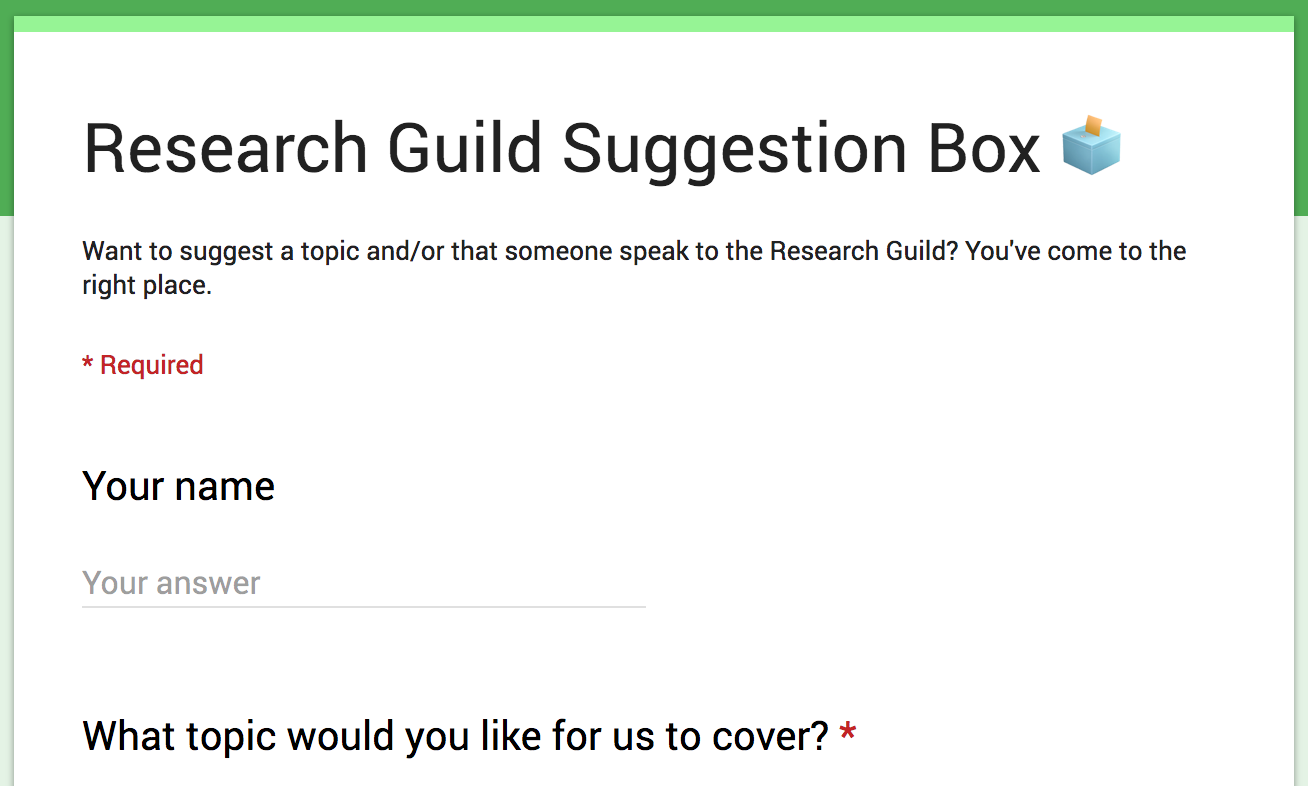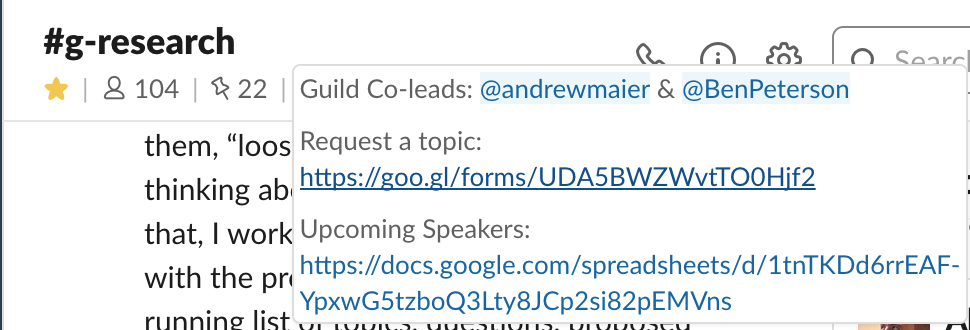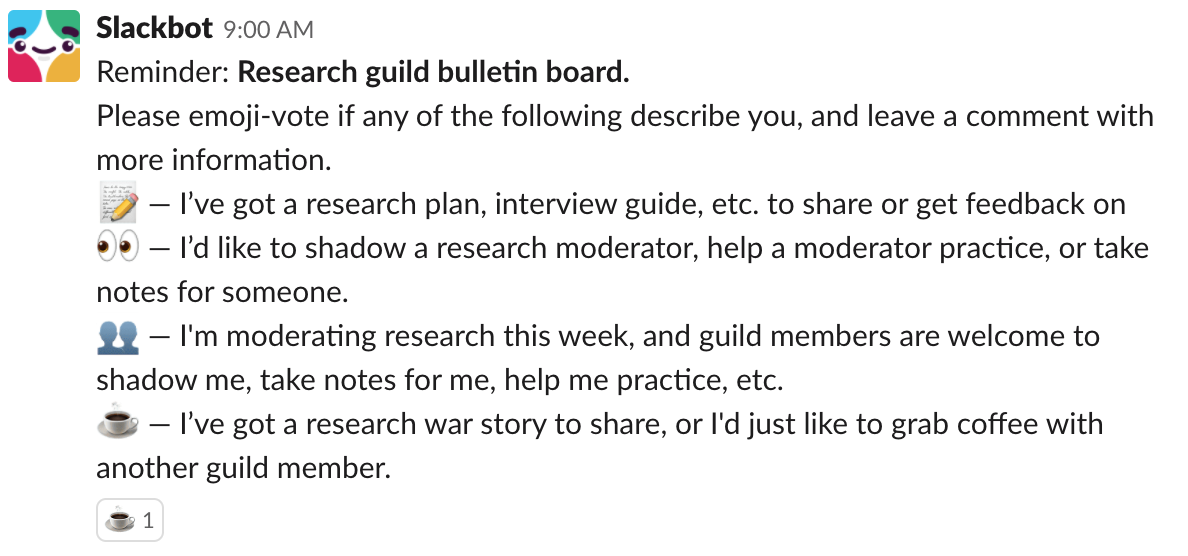Communities of practice are groups of people who share a concern or a passion for something they do and learn how to do it better as they interact regularly. - Etienne Wenger-Trayner and Beverly Wenger-Trayner
The TTS Research Guild is a GSA-local community of practice for design researchers and design-research enthusiasts (to help differentiate governmentwide communities of practice from GSA-local ones, TTS calls ours guilds). A few months ago, my colleague Ben Peterson, with whom I co-lead the guild, and I started brainstorming ways to better position the guild for success. For example, outside of an active Slack channel and a once-a-week video call, we weren’t actively encouraging members to collaborate with one another. Ben and I wanted to change that.
In this article, I’ll review six ways we’ve recently worked to improve the TTS Research Guild, including:
- Publicly sharing our mission and vision
- Writing a lead role description
- Setting goals
- Creating a suggestion box and a speaker series
- Posting a weekly “bulletin board”
- Giving brief presentations about the guild
Publicly sharing our vision and mission
It’s not like the Research Guild didn’t have a mission and vision; we certainly did. It just wasn’t public. Ben and I did the easiest thing and added our vision and mission to a GitHub repository (with the same name as our Slack channel). To wit:
Vision: We envision a world where government agencies use design research to proactively shape their decision-making processes and to inform their design decisions. (Dream big, y’all)
Mission: We exist to build an active, informed, inclusive community of practice for design researchers and design-research enthusiasts at GSA.
Write a guild lead role description
This is another sort of obvious one. A role description helps manage expectations for not only guild leaders themselves, but also anyone who might ask something of a guild leader (including their supervisors, teammates, and fellow guild members).
We arrived at ours after a number of conversations with our colleagues across TTS. TTS Research Guild Leads are expected to maintain the guild as a community of practice, chart a path for the guild, and advocate for and evangelize design research. Discussing the guild lead role also helped us identify the people that guild leads would need to collaborate with—and, consequently, the people we’d need to introduce new guild leads to during onboarding—including:
- The product owner for the 18F Methods (since the methods help us advocate for design research)
- GSA’s Privacy Office (to help facilitate annual updates to our Privacy Impact Assessment for Design Research*)
- The moderators for the governmentwide UX Community of Practice (to help us evangelize design research)
Set clear goals
Once we had a role description in hand, Ben and I started thinking more critically about the kind of community we wanted to build. This wasn’t about basics like “encourage people to talk about design research,” but specifics like creating spaces for reflective research practice and helping people feel comfortable sharing their research plans in progress.
Ben and I drafted a set of 2019 goals and shared them in Slack for asynchronous input. Once the guild agreed on goals, a number of ideas started bubbling up about how we might meet those goals, including a suggestion box, a speaker series, and more.
A suggestion box and a speaker series

A suggestion box is a pretty straightforward idea. It’s not like people couldn’t pipe up in the channel or during a weekly call, but having a “research guild suggestion box” (as a Google Form) made it easy to prompt people to suggest future topics when they join our Slack channel:

The next thing we decided to try was inviting external speakers to lead the guild in conversations about topics or approaches that were new to us. The first person that came to mind was Jessica Ivins, an instructor at Center Centre, the UX design school in Chattanooga, TN. During our initial call, Jessica asked great questions to learn more about the guild and what topics we wanted her to cover; notes from this conversation served as the start of the information we now provide to all potential speakers.
In a nutshell, our speaker series works like this:
- Ben and I identify someone the guild should hear from about a particular topic
- We reach out to a speaker to invite them to speak, and pass along our speaker information page
- We schedule a 30-minute call to agree on a relevant topic and find a date that works for everyone. We follow up with an email summarizing the call, and asking speakers to write us a two-sentence description of their talk and a two-sentence bio
- We pass along to speakers a gratuitous services agreement (in which speakers indicate that they do not expect compensation for speaking to us) and a model release form (in which speakers indicate that it’s okay for us to record their talk)
- Once we receive a signed gratuitous services agreement, we announce the talk to guild members
- We write a quick paragraph that we’ll use to welcome the speaker on the day of the event, and pass it over to the speaker to review
- The day before the event, we briefly meet with speakers to do a run through and ensure everything works as expected.
- We host the event 🎉
- We email the speaker to thank them and ask for feedback on their experience
The Research Guild has hosted three speakers so far in 2019. In addition to Jessica, we’ve heard from Elissa Olinsky (who spoke about accessibility considerations for researchers) and Kate Towsey (who spoke about research operations). And since we’ve reached out to a number of potential speakers, we’ve added frequently requested topics to our guild readme for quick reference.
Posting a weekly bulletin board
As mentioned earlier, outside of joining our Slack channel and attending weekly meetings, Ben and I weren’t seeing very many opportunities for members to collaborate with one another. After a bit of brainstorming, we came up several ideas unique to our community, including asking members to:
- Share stories from past research
- Discuss topics of shared interest (like research participant recruiting)
- Get research done (for example, by collaborating on interview guides)
- Observing research in the act (for example by shadowing members who are already comfortable leading research)
To prompt members, we set up a Slackbot that posts to the channel asking guild members to emoji-respond if they’re up for various forms of engagement. It looks like this:

Initially, we set the posting frequency to once every other week. We didn’t want to spam the channel with automated postings and risk lowering community engagement. Pretty soon, though, it became clear that our “bulletin board” postings were doing a good job of bringing members together to talk about research in action. So now it appears weekly.
Giving brief presentations about the guild around GSA
The last thing we decided to do was hit the digital pavement. To better alert people to the guild’s presence, Ben and I met with our colleagues in GSA’s Office of Customer Experience as well as Jean Fox and Silvia Salazar, who moderate the governmentwide UX community of practice about how we might invite dialog between our communities.
We’ve created a simple, 10-slide presentation to help people know what the guild’s about and why they should join. Our presentation showcases noteworthy guild activities like hearing from GSA’s Privacy Office, discussing 18F Methods, collaboratively planning research, etc.
These are just some of the ideas that we’re trying in 2019 to increase engagement in our guild. Do you run a design- or research-related community of practice within your agency? We’d love to hear ways that you’re improving things and encouraging engagement. Tell us at 18F-research@gsa.gov.

